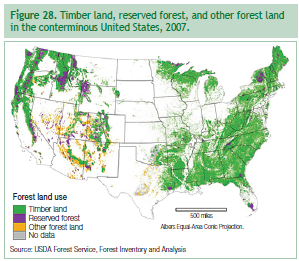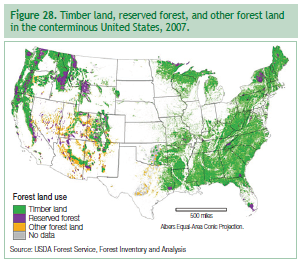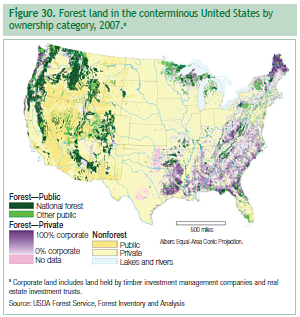
In a recently released report on the Future of America’s Forests and Rangelands, the United States Forest Service (USFS) noted a number of forestland changes expected over the next 50 years.
Across the United States, approximately 751 million acres are currently classified as forest land. At 514 million acres, upwards of two-thirds of this land is also considered timber land. The remaining lands serve non-timber purposes such as recreation, watershed protection and wildlife habitats.

Fifty-six percent of US forests are privately held, and the remaining 44 percent are publicly owned. Across the nation, ten percent of total forest land is protected. This amounts to 42 million acres of reserved forest land in the East and 45 million acres in the West.

Forest Health
According to this USFS report, forests throughout the United States face a number of threats to their long-range health and sustainability. In-depth information regarding major forest health issues is available via the Forest Service’s National Forest Health Monitoring website.
Invasive Species
It is estimated over 58 million acres of forest lands are at risk of invasive pest infestation or disease. Across the West, bark beetle activity combined with severe drought conditions were major contributors to a recent uptick in tree mortality. In the East, the low level of native pests reported is good news. However, nonnative invasive species continue to threaten a number of forests.
Wildfires
Weather patterns, forest stand conditions and fuel loading dictate the amount of forest land burned in wildfires each year. The increasing numbers of wildfires across the West are correlated with rising temperatures and decreased amounts of precipitation.
Climate change is expected to continue to fuel the number and size of wildfires in western forests, according to the report. Wildfires are less of a threat in eastern regions due to varied land use patterns and prescribed fire programs.
Future Forest Resources
For the purposes of this report, the USFS based its projected forest inventories on the United States Forest Assessment System. This model considers the impact of differing biological, physical, and human factors on future forest inventories. Climate related effects are largely muted until the end of the projected period.
Forest Area
According to the USFS, over the past 60 years, timber volume increased by about 50 percent as forest growth exceeded timber harvests. Between the 1980s and 2010, net annual growth of forest land steadily increased in all but the Rocky Mountain region. In the future, forest area is expected to decline, just slightly. Increased land development and fewer planned transitions from agriculture to forest lands are the major contributors to the reversal in this trend.
Forest Types
Forest-type composition is projected to change in all regions. Land use changes, timber harvests dictated by market conditions, management choices, natural succession and climate change will all impact the types of forests seen in the next 50 years.
Eastern Regions
In 2010, softwood pine forests grew across an estimated 39 million acres in the South. By 2060, planted softwood pine forests are projected to number 47 to 67 million acres. In contrast, the total amount of upland and lowland hardwood forest land is expected to decline by one to three percent by 2060.
Few changes are expected in the total number of hardwood and softwood forests found throughout the North. Hardwood forests will continue to dominate northern forest areas. Changes are expected, however, in the makeup of both hardwood and softwood forest types.
Western Regions
Douglas-fir and lodgepole pine forest types are projected to decline in the Rocky Mountain region. However, both fir-spruce-hemlock and ponderosa pine forests are expected to increase in number. The remaining forest types are expected to hold constant.
Changes across the forests of the Pacific Coast will occur mostly on the west side of the region. Here, Douglas-fir forest area is projected to increase, while hemlock-Sitka spruce and alder-maple forests are expected to decline. Projections along the eastern portion of the Pacific Coast region are expected to mimic those of Rocky Mountain region forests.
Forest Inventory
Across all the scenarios run for this report, increased harvest levels to meet biomass energy demands and large scale forest loss due to urbanization result in projected declines in forest inventory. The amount of decline following a peak between 2020 and 2040 varies according to a number of factors. Out of the four scenarios run by the USFS, only one scenario suggests significantly less volume in 2060 than at present, while the remaining three projections show only slight reductions from peak volumes.
Northern regions are projected to experience the greatest reductions in forest inventory. Though the same factors leading to reduced inventory will impact the South, a strong investment response throughout the region is expected to sustain inventory.
Softwood inventories are projected to remain stable throughout the projected assessment period. An established softwood inventory in the Rocky Mountain region along with the aforementioned investment response in the South will keep these stocks fairly constant.
In contrast, hardwood stock inventories are projected to decline as early as 2030 and continue through to 2060. There is little to no hardwood investment expected in response to increased wood energy demand. Additionally, hardwood forests are more susceptible to loss due to land use changes than are softwood forests.
In The Future of America's Forests and Rangelands, the USFS reports that over the past 100 years, the United States has enjoyed relatively stable forest resources and areas. Minor trend reversals due to real estate development and some climate effects are expected in the future. Despite the projected declines in forest areas, forest inventories are not expected to fall below values observed since the 1980s.
The Future of America’s Forests and Rangelands report is part of the 2010 Resources Planning Act Assessment published by the United States Forest Service. The most recent report is the fifth assessment produced to answer a mandate set forth in the 1974 Forest and Rangeland Renewable Resources Planning Act. A comprehensive summary of the current status, observed trends and projected future of the nation’s forests is provided throughout the assessment. The complete report is available for review via the U.S. Forest Service.




